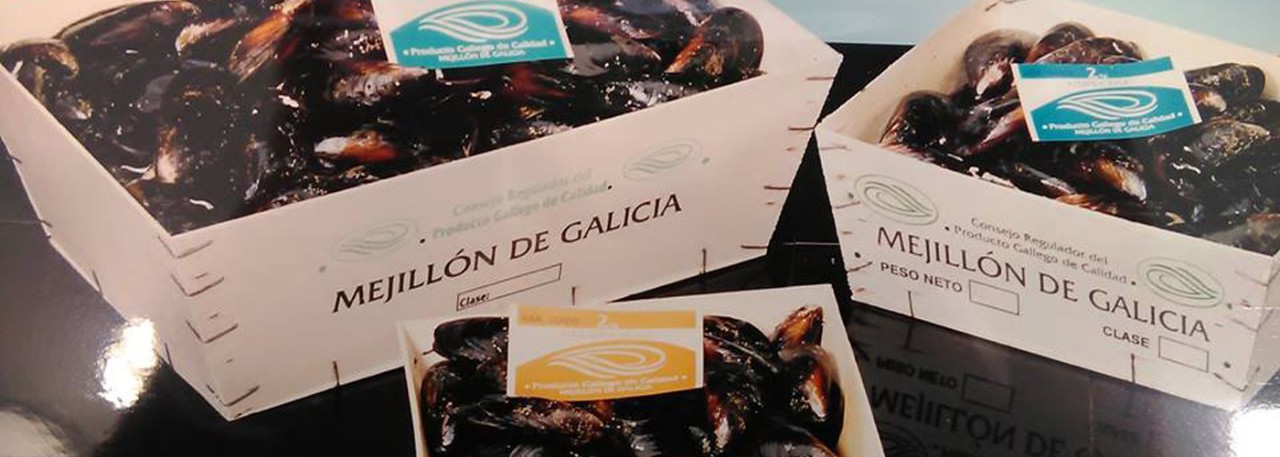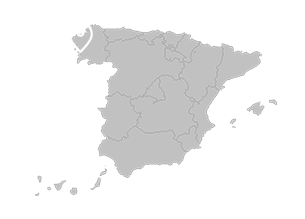.png.transform/rendition-xs/image_image%20(1).png)
Mejillón de Galicia PDO
A bivalve mollusk (Mytilus. galloprovincialis) with a characteristic, pointed hatchet shape, thick on the anterior end and broad and very sharp on the posterior end. A hinge system opens and shuts the valves.
Tasting notes
This variety differs from others because of its bluish-black shell, with concentric lines (growth marks), and especially because of the orangey-cream mantle which is very different to the white color found in other production areas. Along the edge is a curvy, dark purple strip.
Other notes
As food, Galician mussels have high protein content with similar nutritional value to hake, lobster and most edible marine animals.The specific morphological, physiological and genetic characteristics of these mussels are as follows:Morphology
- Color of the edge of the mantle: Violet or dark purple
- Anterior abductor muscle: Small
- Hinge: not long
- Pointed apex: curves inwardsPhysiology
- Sexual repose: short
- Heart rate at the same temperature: lower
- Gamete release when together: at different times
- Resistance to low temperatures: down to 7ªC
- Oxygen consumption: decreases as from 25ºC
- Resistance to low salinity: down to 19 per milGenetics (allele frequency)
(Allele frequency is the order in which the genes and their bases are found in each chromosome. Variations cause mutations and lead to natural selection, which results in evolution of the species.)
- Allele 90. Est-D 88-95%
- Allele 108. Lap-I
- Allele 100. Est-D 1-6%
- Allele 100. MP-1
- Allele 100. Lap-I 3-6%.
Production / Processing method
Production mainly follows a very traditional system mostly involving family-run operations on floating Rafts called bateas, from which ropes hang. These structures are made up of the following parts:
Frame: A more or less rectangular network of wooden bars having a maximum surface area of 500 m2 (1,640 ft2), from which the ropes hang,.
Floating system: This has varied over the years. The first floats were the hulls of old boats or wooden tubs but these have been gradually replaced by polyester tubes or polyester-coated iron cylinders.
Anchorage: The platform is anchored by one or two chains linked to concrete blocks.Cultivation method: A maximum of 500 ropes no more than 12 meters (39 ft.) long are tied onto the frame. In order to distribute the weight of the ropes and prevent them from coming loose and losing the mussels, every 40 cm (15 ½”) a wooden or plastic rod is inserted.The cultivation process for Galician mussels involves several stages:
Obtaining seeds: These are obtained in two ways. From October to April, producers scrape mussel seeds from rocks, and from March to June, they hang collector ropes from the bateas to capture larvae.
Seeding: The seeds measuring 1-2 cm (¼- ½”) are taken to the platform where the “seed ropes” are prepared. The baby mussels are attached to the rope using a thin rayon thread which breaks down a few days after submersion in the sea, by which time the mussel will have attached itself to the rope by means of its byssal threads. This operation can be done by hand or using purpose-built equipment.Separation: After 4-6 months in the sea, when the mussel has reached a size of 4.5-5.-5 cm (1½ - 2”), the seed ropes are raised. At this stage, the considerable increase in size of the mussels makes it necessary to increase the number of ropes, lowering the density of mussels per rope, thus promoting growth and preventing the mussels from being forced off.
From each seed rope, two to three ropes are made, all of which are returned to the sea.The PDO mussels feed by filtration off the phytoplankton they find in the sea water. They have an exceptional capacity for filtration – up to 8 liters of water per hour. They reach commercial size – 70-95 mm (2½ - 3½”) – in about 17 months, very little in comparison with other producer areas which need two to six times longer to reach this size.
Harvesting and selection: Once the mussels have reached the necessary size, the ropes are lifted out of the water by crane and transferred to a boat. On the deck, they are washed with plenty of seawater, sorted and classified by size. They are then placed in plastic sacks for transfer to the distribution centers.After production on the raft, the mussels go through the following stages:
1. Removal from the raft
2. Selection and placing in bags
3. Transport to land by boat
4. In the harbor, quality control and product certification.From this point on, the process varies depending on whether the mussels are to be consumed fresh or are to be processed
Fresh mussels:
1. Transport In bags to the cleansing plant
2. SaleProcessed mussels:
1. Removal from the raft
2. Transport to land by boat
3. In the harbor, quality control and product certification
4. Transport to the processing plant.The mussels are then subjected to physical procedures, which take place in a different order depending on the end product:
Type 1:
1. Pressure washing and mechanical de-bearding
2. Vacuum packing
3. Cooking
4. Freezing
5. Sale
Type 2:
1. Washing under pressure
2. Cooking
3. Separation of meats by immersion in a saline solution or by laminar flow
4. Mechanical or manual classification under strictly-controlled hygiene conditions.
5. FreezingThe product is sold in packs having the following characteristics:
- Unbreakable, with a coded label issued by the Regulatory Council
- Legally-permitted materials
- Established quality parametersIn the cooking and freezing processes, most of the physical and organoleptic characteristics are retained.
Traceability is guaranteed throughout the process.
Geography / Relief and climate
The coastline of Galicia is about 1,200 kilometers long. The rías are former river valleys which, as a result of tectonic processes, were invaded by the sea. They offer ideal ecosystems for mussel cultivation. The excellent environment with warm water temperatures and high primary production make this an ideal location for mussel cultivation.
Regulatory Council
Consejo Regulador de la DOP Mejillón de Galicia
Avda. de Mariña, 25. Planta 1.
36600 - Vilagarcía de Arousa (Pontevedra)
Tel: (+34) 986 507 416
info@mexillondegalicia.org
www.mexillondegalicia.org/
Sources:
- Spanish Ministry of Agriculture- Regulatory Council, Mejillón de Galicia PDO
- OPMEGA (Mejillón de Galicia producers’ organization)
Galician mussels have high protein content with similar nutritional value to hake, lobster and most edible marine animals.
Galician mussels have high protein content with similar nutritional value to hake, lobster and most edible marine animals.


- /content/dam/en/icex-foodswines/images/products/farmed-fish---aquaculture/mejillón-de-galicia-pdo/Mejillón%20de%20Galicia%20PDO%20carr1.jpg
- /content/dam/en/icex-foodswines/images/products/farmed-fish---aquaculture/mejillón-de-galicia-pdo/Mejillón%20de%20Galicia%20PDO%20carr2.jpg

Vilagarcía de Arousa (Galicia)
